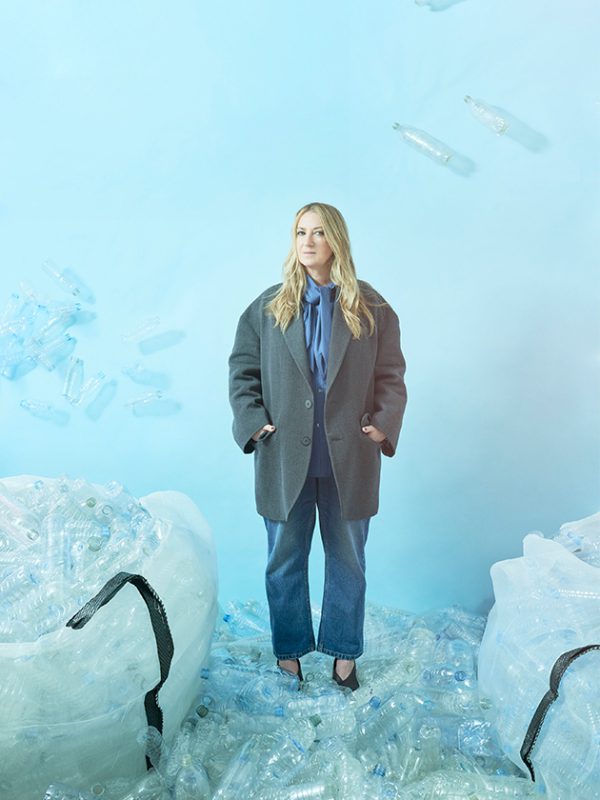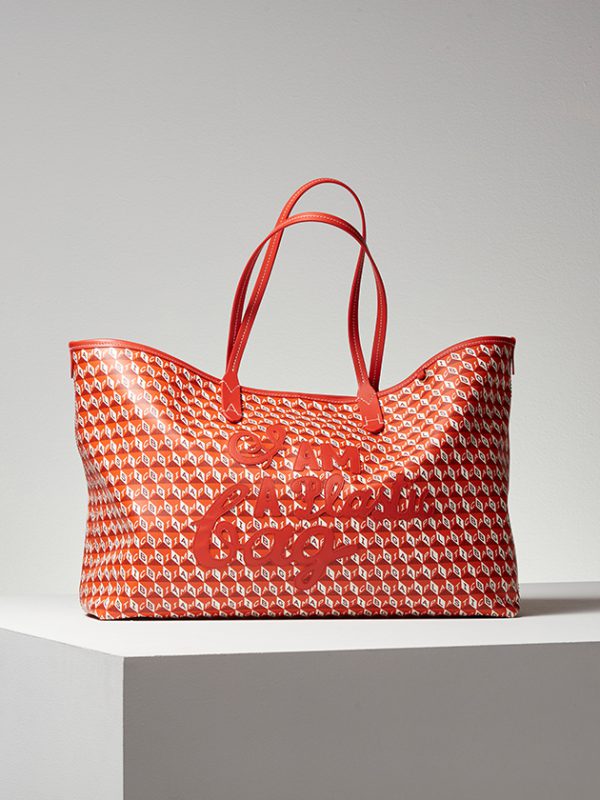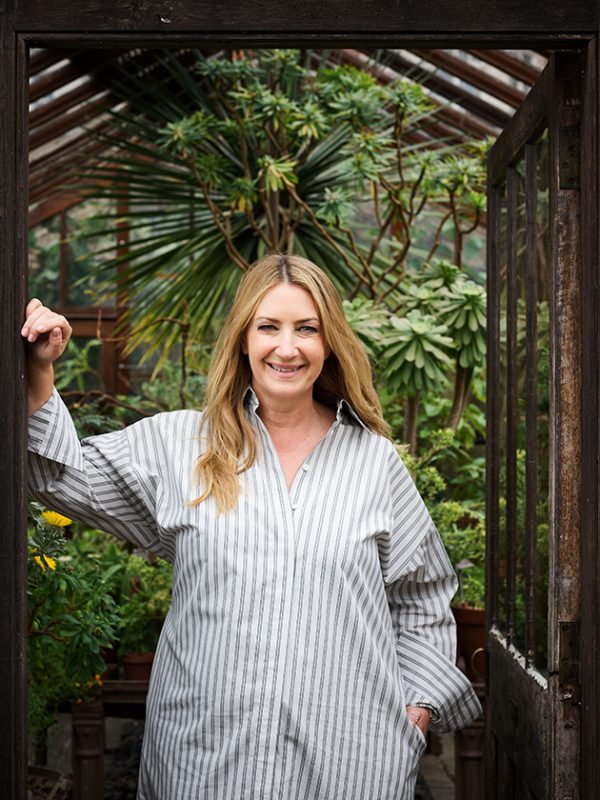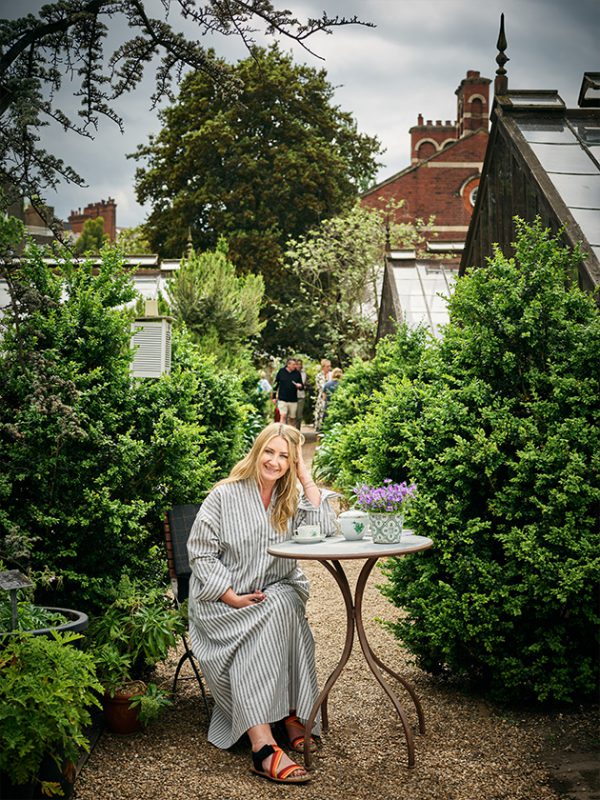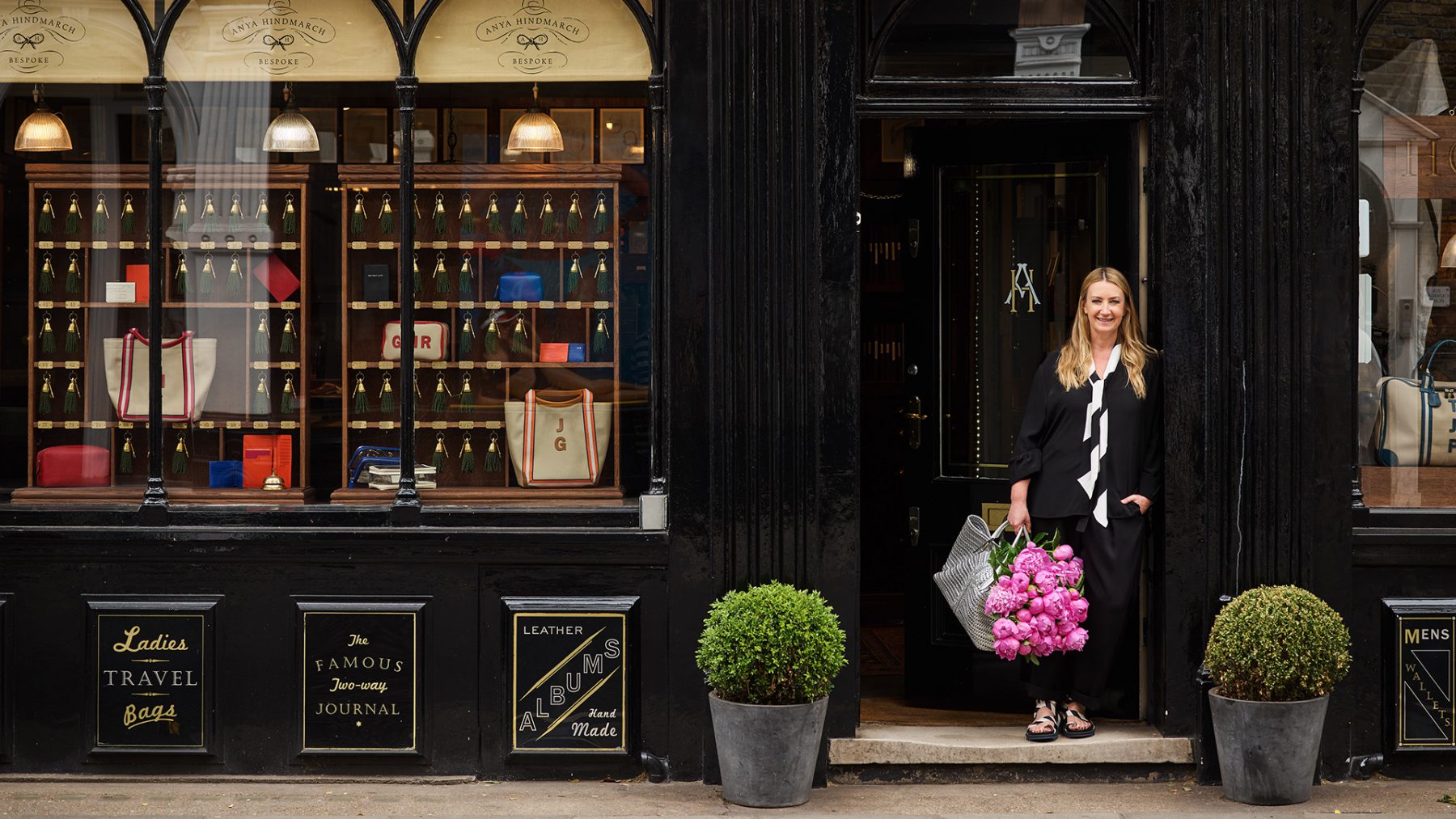Anya Hindmarch by Michaela Cordes | 4th September, 2020 | Personalities
She’s the iconic designer, founder and comeback CEO of luxury leather goods brand Anya Hindmarch. For this businesswoman and mother of five, fashion always also meant taking on responsibility. Her latest collection is made from recycled plastic bottles.
„I’m not an eco-warrior, I’m just trying to use common sense.“ ANYA HINDMARCH
Anya Hindmarch did a beautiful, shocking thing last February during London Fashion Week. Just weeks before the coronavirus hit, she closed all her London shops and filled them with 90,000 used plastic bottles. A powerful demonstration of how much the world population consumes in the blink of an eye – and a marketing coup that not only drew attention but helped her launch her innovative I Am A Plastic Bag collection of handbags. A passionate project that took two years of research and travel between Taiwan, Florence and London, where we met the British powerhouse.
Ms. Hindmarch, Plastic pollution appears to be an ever-growing problem. Eight billion tons of used plastic enter our oceans every year. The New York Times just published an article stating that “plastic pollution isn’t just fouling the world’s oceans. It is also in the air we breathe, traveling on the wind and drifting down from the skies, according to a new study. More than 1,000 tons of tiny fragments rain down each year on national parks and wilderness areas in the American West alone, equivalent to between 123 million and 300 million plastic bottles’ worth.” Your new handbag collection offers a way to deal with single-use plastic – not by throwing it away, but by re-using it to create a new material.
Anya Hindmarch: I learned a lot from our first project I’m Not A Plastic Bag for which we raised awareness about single-use plastic 13 years ago. People in Asia, Europe and the U.S. were queuing for our £5 bag. Partly as a result, consumption of plastic shopping bags in the U.K. fell from 10 billion to 6.1 billion. Soon afterwards, the country started banning plastic shopping bags and passed a law requiring businesses to charge for them. But here we are in 2020 and the problem is far from solved. Rather than adding to landfill, we asked ourselves: How can we re-use what is already on the planet? So we spent two years developing our new I Am A Plastic Bag collection. The technology is quite interesting: We take PET water bottles, crush them and clean them and melt them into pellets before spinning them into yarn. The reason it took us so long to develop the collection was that I wanted to create a truly beautiful, quality canvas. Something that looked natural and that people would love to touch. We worked with an amazing supplier, too. But what is totally unique is the coating that protects the outside of the bag. Here we used PVB, the film that is put between layers of glass in car windscreens to prevent them from shattering when smashed. We managed to extract the material and coat the bag with it.
How many plastic bottles are being used for making one of your bags?
Each bag uses approximately 32 half-liter bottles, plus the re-used plastic from the windscreens of used cars. So it’s a really nice thing that every time you carry this bag you are actually saving plastic bottles from landfill. For me it was all about sending a signal about how to focus on the circular economy, showing how you can use this material to make something, wear it and then turn it into something else. How to make this circularity possible – how to use the things we have already instead of producing more.
What were some of the challenges you faced?
It’s been quite fascinating because I also learned a lot about leather. When we started this project, I thought we should use recycled leather for the piping, but interestingly, what they do to old scraps of leather is shred it into a kind of sand dust and then mix it – with plastic! (She laughs) That didn’t seem like the most sensible thing to do. We then looked at vegan leather, but that’s also plastic! So we circled back to leather that is handled as responsibly as possible: minimal water usage, local hides, no deforestation from Gold-rated Leather Working Group tanneries. That’s where it comes back to common sense. After all, leather is a by-product of the meat industry. After talking to many experts, we came to the conclusion that this route was the most sensible one until there are true alternatives.
What did you learn during that two-year time period?
To me it’s very important not to criticize what’s not yet perfect, but to praise the steps that have been made. Many people are too scared to even get started. But if everyone just does five or ten percent, it’s amazing how much you can rethink. Because of our project we also started looking at how we were dispatching our orders. We used to send them in beautiful bags and boxes with all kinds of paper – crazy! So now we just have a beautiful card that says: Please go online. Everything you need to know you will find there. And we now work with recycled wrapping paper. We’re not perfect, but we’ve made a massive difference. So here is my advice: Whatever you can do today, don’t hold off. Just get started.
Where do you produce the recycled canvas from the plastic bottles that are made into yarn?
The fabric is produced at a mill in Taiwan. It’s far away from my bags, which are normally all made in Florence, but it’s the only place that can do this. And interestingly, Taiwan used to be called “Garbage Island” in the eighties because they had such an issue with waste. Today, they are the number three or four in the world when it comes to recycling. But I am hoping to be able to go more local quite soon and make this fabric either in Italy or Spain. One thing we are really doing is saving a lot of bottles with this bag!
You seem to have become one of the pioneers in the fashion industry. How did people react when you closed your London stores for Fashion Week and filled them with 90,000 used plastic bottles – the equivalent of six seconds of the world’s single-use plastic consumption?
I sit on the board of the British Fashion Council and we talk a lot about what Fashion Week is and how it must change and reflect what is going on in the world. We as a company felt we needed to communicate this project, which was a huge project in itself. It was so hard! Every person in our company of about 150 had to collect plastic bottles. Then we needed to peel off all the labels and clean the bottles. Overnight we closed three of the four stores we run in London and stored the 90,000 bottles between them. It was kind of shocking to see. People were just stopping, taking pictures. But it really did drive the point home. It was a very weird feeling for me to be sitting at home during Fashion Week with all my stores closed, but the reaction was phenomenal! We launched the stores, but only sold the I Am A Plastic Bag collection online and on Net-a-porter. The bags sold out in a day! I was nervous beforehand – because I put my head above the pack. This was a bag that was selling for £600 whereas the last one sold for £5. But it is a beautiful, beautiful bag – all finished by hand. It is a feat of modern craftsmanship. You simply can’t do lovely things cheaply. When the fabrics from Taiwan arrived at the factory in Italy, every fabric roll was behaving slightly differently because it was produced from different bottles. There was a lot of engineering and craftsmanship involved in the process. I wanted to be really upfront about everything, so we put a video on our website explaining all the steps. I wanted to say: This is what we’ve done. I’m no expert, but this is what I researched. I’m not an eco-warrior – I’m just trying to use common sense.
Your projects and bags seem to speak to celebrities immediately. Keira Knightley became a fan of your I’m Not A Plastic Bag project back in 2007. Reese Witherspoon was one of the first to post very actively when your new bag came out …
She is so sweet! I love Reese. This is one of her real topics. And she’s a smart woman with a lot of depth. She also has the influence to encourage people to spend their money on beautiful things. I think people want to be given a chance to make a difference, but without having to make too much of a sacrifice. And there certainly are ways to give people alternatives that aren’t too boring or ugly or difficult. I think we are all really worried about the planet. We all think that this is a climate emergency for sure. And I think people care. (Editor’s note: Anya Hindmarch used the pandemic to launch another thoughtful project for which she created more than 1.500 specially designed Holster bags to the British NHS Trust so that medical staff could easily access and carry their belongings while working during the coronavirus outbreak.)
I personally loved the Sticker collection you launched a few years ago – and became aware of your brand because of its humorous approach. There always seems to be an element of not taking life or yourself too seriously.
I think I don’t take myself too seriously because I am aware that fashion doesn’t save lives but is an important employer. Fashion certainly influences how we feel, affects our confidence and how we behave. But I have always thought that it should put a smile on your face. Personally, I can’t take fashion too seriously. But It’s also about having a bit of luxury, which is quite important to me too.
“As a teenager, I wanted to be an opera singer, but I come from a very entrepreneurial family.” ANYA HINDMARCH
As a teenager, what did you want to do with your life professionally?
I wanted to be an opera singer! I used to sing a lot in school. But I come from a very entrepreneurial family. My older sister and my younger brother both have their own businesses and my father started his when he was very young, eventually turning it into a really big business that had to do with plastics. Yes, he was a plastics engineer! It’s hilarious if you think about it. I grew up around plastic factories. My father invented the plastic flower pot. They used to be made out of clay. We have lots of very funny debates because he says – and I do agree with him – that in many ways plastic is actually quite a brilliant material. The problem is how people use plastic. The man who invented the plastic shopping bag, his son recently said: My father would be turning in his grave because he developed it to stop so many trees from being cut down in order to make paper bags. He carried a single plastic bag in his pocket all his life. Plastic, interestingly, has a pretty light footprint. If you talk to a lot of people, they’ll say you should wash and re-use your plastic water bottle. I have my juice bottle – I bring in my green juice every morning – and I wash it and take it back with me to the office the next day. I’ve probably been using the same bottle for four years.
You wanted to become an opera singer but ended up as a handbag designer – can you explain how that happened?
Even as a young child, I loved making little wallets and containers out of paper. And having different places to store things. I love organization and I think handbags are all about organization. I myself am a super tidy person – in a really sad way. (She laughs) When I was a student I went to a lecture at school by a girl who was working in the fashion industry and she came to talk to my class. I remember that afterwards I went back to my desk and drew my first shop. I knew I wanted to have a shop and I wanted to sell leather goods. My mother gave me a handbag when I was 16, it was one of her old ones. I remember how it made me feel how much I loved the craftsmanship and the way it was made. So when I left school I didn’t go to university, I went to Florence because I wanted to spend time near the factories to understand the world of handmade leather goods. Later, I started out making bags there and selling them in England. I never had any official training but I learned very closely with the craftsmen. After that, we started our own production in England as well, opening our first shop, then more shops before finally going into wholesale. The business grew and grew in a natural way.
What is your vision now – after taking over again as CEO and Creative Director. Where do you see yourself and the business in the next five to ten years?
Things are quite different now, actually. Having 55 stores around the world – all the same – no longer feels modern. I used to fly to Paris to see the person who makes my glasses and I could only buy them in Paris – which was so much more exciting. Now I want to also be able to order online. So I think what we want is a much smaller retail footprint. The retail experience is something that you can’t do online, so it’s a reason to go. I also think we want a very strong digital distribution that’s direct to the customer, very first-person. Wholesale and department stores are having a pretty tough time because the digital world has made it difficult for them to have an edge. So we are working only with the best department stores, but in a way where we do something exclusively with them. Otherwise everyone starts offering discounts too early. It’s a very different model, but we’ve got some quite strong ideas.
“Plastic is a brilliant material. The problem is how people use it.” ANYA HINDMARCH
You were also always quite busy outside your business and have raised five children – how old are they today?
I married a widower – my husband’s wife died six months before I met him. It was a very sad story, actually. He had three children, aged one, three and four. And then we met and married and waited a while but then had two more. So we have five children. Today the oldest is 31 and the youngest is 17.
Could you tell me how you managed all of that: building a company as a mother of five and maintaining what appears to be a wonderful marriage?
My husband and I work together. We feel very lucky, and we split many of the roles, which helps a good deal. But it’s a lot of organization and a lot of work. It’s good fun, though. He takes care of the business development, legal and finance aspect. All the sort of stuff I don’t like doing. Sure, it can be hard at times. But it worked for us. We were expecting our first child when he joined the company 19 years ago!
What else are you passionate about besides your company? How do you recharge your batteries?
I like to drink wine. (She laughs) Life is quite busy. My favorite thing is being at home at my kitchen table with friends, with a roasted chicken, very simple. I don’t love the red carpet treatment, none of that really matters. I like good friends and a nice bottle of wine, the simple life, a house full of kids. We enjoy nice holidays, spending time with the kids and seeing the world. That’s one thing I find very hard to give up in these times of environmental consciousness because I find travel so important for education.
When you look back to 33 years ago when you founded your company and compare your typical customer then to your customer today – has she changed?
I guess we are right back where we started. Then and now, we’re looking at women from 25-50, people who aren’t so crazy about showing off their money and the initials of brands. They’re interested in something that lasts, fulfills a purpose, stands for a certain point of view. My belief is that your accessories should make your life easier and more efficient.
And today, if you own something by Anya Hindmarch you’re also making a statement!
I always, always cared. That has always been and will always be very important to me.
